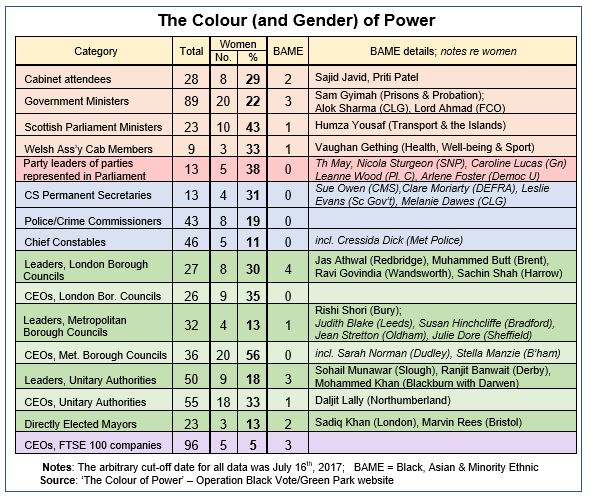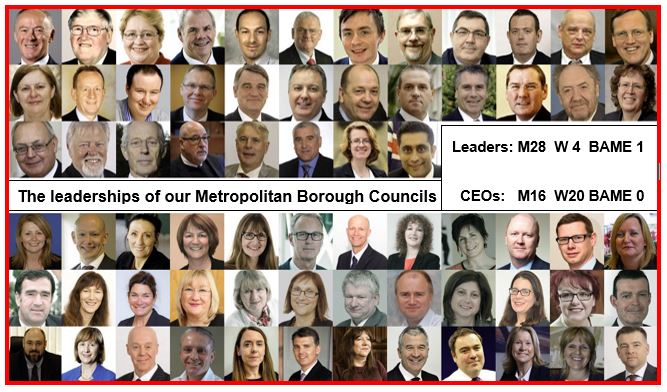Chris Game
As a blogger, I see myself as a kind of Middlesbrough in the Premier League: beigey. Not significant enough to attract the serious detestation of a Chelsea or Man United, but nor with the widespread likeability of a Bournemouth or Burnley. It means any feedback I receive is rarely obscene and generally supportive or constructive – an example being my recent blog on the West Midlands Combined Authority, whose initials, I’d suggested, could stand for “the (almost) Wholly Male Combined Authority”.
A respondent from Localise WM, a not-for-profit organisation that promotes local trading, tweeted that the initials “could alternatively stand for White and Male Combined Authority”. And they were quite right. The figures are identical: one woman member and one (different) BAME member on the currently 33-member WMCA Board.
I had two main reasons for omitting any discussion in that blog of the minority ethnic dimension. First, space. I wanted to record not just the statistics of women’s under-representation in the elected Combined Authority world, but the efforts to improve that representation in, for example, Greater Manchester and Liverpool, prompted by local women’s campaign groups.
The second reason was that I was aware of a project on the point of publication that would almost certainly furnish the data to enable a more informed and better illustrated discussion. Not, as it happens, this week’s delayed launch of the Cabinet Office Race Disparity Unit, intended to monitor how public services discriminatorily treat people from different racial and ethnic backgrounds. I had in mind the Guardian newspaper’s international Inequality Project, a small but important part of which is ‘The Colour of Power’ (CoP) study undertaken by Operation Black Vote and the business management company, Green Park.
The CoP website suggests that “when we embarked on this journey, we did not know exactly what we would find”. Commendably open-minded, but my guess is they actually had a VERY good idea of what they’d find – that “in 2017, pathways to the very top jobs for Britain’s black and minority ethnic communities are almost non-existent” – and wanted to use an obvious but still highly effective means of quantifying and publicising it. The actual figures they recorded were that “for over 1,000 of the most senior posts in the UK, only 3.4% of occupants are BAME [30 men, 7 women], and less than 24% women”.
Shocking as such statistics ought to seem on their own, pictures are harder to ignore or refute – one reason why the row over the BBC presenters’ gender pay gap took off so instantly: we knew what most of them looked like. And it was why, following the similar 2016 #Oscarssowhite furore, the New York Times produced its famous ‘Faces of American Power’ feature, actually picturing the faces – and genders and colours – of the ‘Power People of America’.
That’s precisely how ‘Colour of Power’ have presented their data. There are 37 sets of pictures in all, from the CEOs of FTSE 100 companies, public bodies, advertising agencies and top charities to editors of women’s lifestyle mags and Premier League football managers – a selection of which, mainly from national and local government, I’ve summarised in my table.

Knowing an albeit ludicrously dated authorial photograph would accompany this blog, and having recently celebrated my no-longer-titian beard’s 40th birthday, I did briefly contemplate adding a facial hair column to the table. But it turned into a version of the even older Peter Cook sketch, about it being only his lack of Latin that prevented his becoming a judge, rather than a coal miner.
It became apparent that my becoming not just a Supreme Court Judge, but a Chief Constable, Permanent Secretary, or CEO of a top bank, was effectively stymied from the outset by the beard. Easily my best chance of even proximity to power would have been, like Jeremy Corbyn, to become a party leader, with three of the eight male leaders unvictimized for their full facial hair.
I did, though, want to illustrate CoP’s method and presentation, and I chose the politician and officer leaders of the councils which, outside London, have the highest numbers and proportions of BAME residents: the 36 metropolitan boroughs, with approaching 2 million or nearly 15%. I wasn’t expecting the councils’ members and officers to reflect these figures in any statistically significant way, but I did think they might come fractionally closer than, say, unitaries. So it was fortunate I didn’t put money on it.
Operation Black Vote, ‘The Colour of Power’, BAME political representation, International Inequality Project, Race Disparity Unit, women local authority CEOs

A few of the leaders were apparently camera-shy, but the contrast between the M/F balance of leaders and CEOs – here particularly, but in councils of all types – was something else I hadn’t entirely anticipated. The clear majority of women CEOs in the mets, incidentally, was the only such figure apart from the MDs of media agencies and editors of women’s fashion and lifestyle magazines – and I did briefly consider using just the middle row, or even the phalanx of five just left of centre.
Which would have been a nice positive note on which to close, but in the circumstances also a false one. For the message of the CoP exercise – the almost complete absence of BAME faces, here and throughout the local government tables – is simply an embarrassment. Yet these are the people responsible, accountable even, for many of the services producing the disparities and ‘burning injustices’ that the PM and her Disparity Unit are pledged to eradicate. Quite an ask.
 Chris Game is a Visiting Lecturer at INLOGOV interested in the politics of local government; local elections, electoral reform and other electoral behaviour; party politics; political leadership and management; member-officer relations; central-local relations; use of consumer and opinion research in local government; the modernisation agenda and the implementation of executive local government.
Chris Game is a Visiting Lecturer at INLOGOV interested in the politics of local government; local elections, electoral reform and other electoral behaviour; party politics; political leadership and management; member-officer relations; central-local relations; use of consumer and opinion research in local government; the modernisation agenda and the implementation of executive local government.